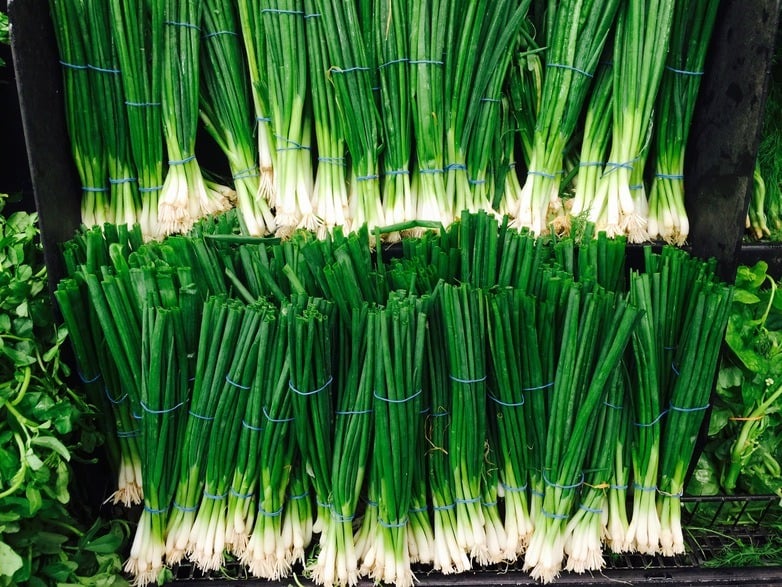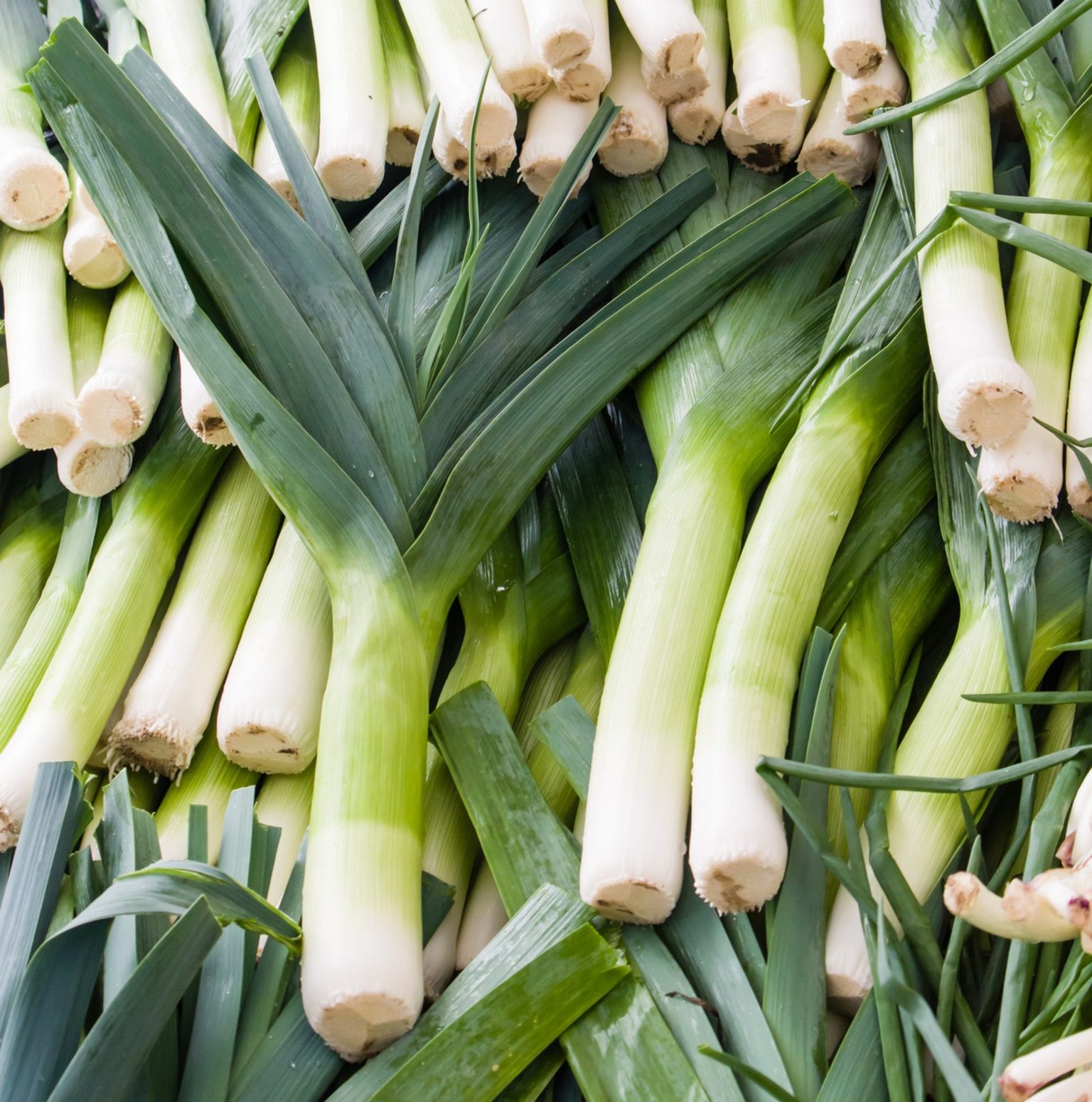How to Use Every Part of Scallions, Spring Onions and Leeks
Additional reporting and updates by Katherine Sacks.
When a recipe calls for scallions, spring onions or leeks, the ingredient list generally requests “white and pale green parts only.” The instructions might have good intentions, suggesting you use the extra greens in another recipe, but more often than not, those leek tops and scallion tops end up trashed.
But scallion, spring onion and leek tops are full of nutrition and they can bring a bright blast of onion-y flavor to your dish. Throwing them away is like tossing out flavor, tossing out food, and, well, tossing out money. So, waste these mean greens no longer. Follow these tips for using all of the parts of these lovely, oniony vegetables.
Storing Scallions, Spring Onions and Leeks
The first step of cutting back food waste is proper food storage. With alliums (aka any vegetable in the onion family), the key is to keep them hydrated, while also reducing moisture so bacteria can’t form. Wrap the root end of scallions, green onions or leeks in a damp towel, then store in a produce or perforated bag. And FYI: although leeks are notoriously packed with dirt, don’t wash them before you refrigerate; they will spoil faster!
Cooking Scallion and Green Onion Greens
Scallions and green onions are young fresh onions; the names are used interchangeably and you’ll know them by their long green leaves, slender white stalks and stringy roots. Recipes often call for thinly sliced scallion or green onion whites as a garnish, adding a sharp bite as the finishing touch. The green leaves are much less pungent and add mild onion flavor where the lighter parts would overpower a dish. Because their flavor is so delicate, you can use scallion greens raw or in larger quantities. Cooked, they mellow even more, bringing subtle flavor and bright color you won’t get with the white parts. Try them in some of these dishes:
- Charred: Throw scallions on the grill whole, then serve with Romesco sauce like they do in Spain.
- Pureed: Turn scallion greens into a lovely chimichurri sauce, blending them with fresh herbs, olive oil, wine vinegar and seasonings. It’s a great topping for grilled meats, fish or vegetables.
- Garnish: Substitute minced scallion greens for chives in just about any recipe. Perfect for topping soups, adding into salads and stirring into mashed potatoes.
- Tarts and quiche: Add scallion greens to the filling of a tart, quiche or Spanish tortilla.
- Scallion pancakes: These crispy Chinese pancakes make a quick, delicious way to use those greens.
- Scallion spread: For an easy, onion-y dip, combine equal parts goat cheese and cream cheese with finely chopped scallion greens, salt and pepper.
- Scallion hummus: Add some chopped scallion greens to your next batch of hummus for a colorful, flavorful boost.
- Gremolata with scallions: Substitute scallion greens for parsley in this classic Italian condiment. For smoky flavor, grill the scallions first. Sprinkle a pinch of this zingy garnish on slow-roasted foods to brighten their flavor.
- Scallion top compound butter: A pat of scallion-infused butter can brighten so many dishes: top cooked chicken, fish or steak with it; stir into hot cooked rice or pasta; or slather on grilled bread. And it’s easy to make: combine chopped scallion greens with seasoning and softened butter, then chill.
- Go Korean: Scallion green salad — thinly sliced scallions tossed with soy sauce and Korean chili paste — is such a popular dish in Korea, grocery stores sell pre-cut scallion greens and there’s a special tool used to cut them very thin.
- Use it all! You can always just ignore the recipe and use the whole scallion or green onion — white root to green tip.
Cooking Spring Onion Greens
Sometimes spring onions are confused with scallions and green onions, and while similar, they aren’t exactly the same. Scallions and green onions don’t form a bulb (making their thin white ends great for slicing), while spring onions have a large, pungent white bulb and thicker, tougher green stems. If you purchase spring onions young and small, you can use them in some recipes calling for scallions, especially when the onion is cooked. Here are a few ways to try them out:
- Cook them low and slow: Roasting or braising helps mellow out and break down the larger bulbs and thicker stems of spring onions, creating a silky, luxurious side dish.
- Grill them: As with scallions, grilling spring onions whole is a great way to go. Add them to a mix of other grilled veg for an easy salad or toss the charred greens on top of pizza.
- Go Tempura-style: Dip them in buttermilk and flour, then fry whole for a delightful side dish or appetizer. This recipe calls for whole spring greens, but you can easily just fry the green leaves if you’ve made use of the bulb elsewhere.
- Celebrate spring with soup: Spring onion soup is one of those fresh, bright classic flavors that celebrates the earliest vegetables of spring.
- Cook them with peas, favas and morels: There’s a reason they say what grows together, goes together. Spring onions marry so well with their springtime produce brethren. Whether you use the whole onion or just the greens, try pairing peas and spring onions in soup; spring onions with morel mushrooms in a savory tart or quiche; or fava beans, morels and
- Make stock: Spring onion greens are tougher than their scallion brothers. If you buy them super big, it’s best to toss them in the stock pot and create a flavorful broth for your next batch of spring onion soup.
Cooking Leek Tops
In the field, leeks are tall gangly things with green tops that may grow several feet high. In the market, they are usually trimmed for easier handling, but even then there is still a substantial length of the green leek tops left for home cooking.
Leek tops are more fibrous than the white and light green part of the plant, so they need a little extra attention in the kitchen. Cutting them very finely is one way to deal with their toothsome texture. Cooking them for a long time or at a high heat will do the trick, too. Here are a few ideas for using up your leek greens:
- Grilled leek greens: The char of the grill is a delicious complement to leek greens, both tenderizing the vegetable and adding smoky flavor.
- Use them as a cooking wrap: Use leek leaves like banana leaves to wrap foods before steaming or grilling, or place them at the bottom of a bamboo steamer when cooking chicken of fish. The leek wrap protects the food from drying out and imparts a little onion flavor to the dish.
- Leek pasta sauce: Braise the leek greens in a little stock. Puree until smooth with ricotta and parmesan cheese, then toss with pasta.
- Leek stuffing: Put leek greens in the cavity of a chicken or turkey before roasting to flavor your bird.
- Sauteed leek greens: Saute chopped leek greens with fatty pork such as bacon or pancetta for a tasty side dish.
- Stir fry leek greens: Stir fried leek greens make a popular Asian dish.
- Vichyssoise: Add leek greens to this classic French recipe for a root-to-stem soup (see recipe below).
- Frizzled leek greens: Slice leek greens very thinly and flash fry in a little neutral flavored oil for a tasty, garnish.
- Braised greens: Slow braising makes leeks and their greens meltingly tender.
- Pickled leeks: Persevering leek greens in a bright pickle is a great way to break down their tough texture and make them last longer. Serve on a cheese board or a sandwich.
- In soups, stocks, stews: You can always toss leek greens into the stock pot for both veggie and meat broths!
Recipe: Not Vichyssoise
Sherri Brooks Vinton
Serves 4
Many French recipes, such as the classic chilled potato and leek soup Vichyssoise, call for only the center of the leek. The look is perfection, the flavor divine — but the recipe also leaves a large pile of trimmings behind. In this recipe, I’ve included the dark green parts of the plant as well. The final dish has more color and a more onion-forward taste than traditional Vichyssoise, but it reduces waste and that is a beautiful thing.
Ingredients
2 leeks, sliced 1” thick
2 tablespoons butter
Kosher salt and freshly ground black pepper
1 pound starchy potatoes, such as russet, chopped into 1” pieces
1 quart chicken or vegetable stock
1/2 cup heavy cream
Method
- Add the leeks and butter to a medium stock pot. Season with salt and pepper and cook until over medium until leeks begin to soften, about 5 minutes. Add potatoes and stock and bring to a boil. Reduce the heat to a simmer and cook until the potatoes are falling apart, 10-15 minutes.
- Remove pot from the heat and puree with a stick blender or in a standard blender. Strain soup through a fine mesh strainer placed over a bowl, using the back of a wooden spoon to press out all but the potato peels and leek fibers. Whisk in the cream and season to taste.
- Wipe out pot and add soup. Bring to a simmer and heat gently until warm. Or cool completely and serve soup chilled.
More Reading
15+ ideas for delicious meatless grilling
July 1, 2025
4 Tips for Stretching Your Food Dollars
April 16, 2025
How to use extra onions
April 9, 2025
Our latest podcast episode on pistachios: The making of a food trend
April 1, 2025
This vegan tiramisu will bring you joy
March 11, 2025
For lessons in thrifty, climate-friendly cooking, look to vintage cookbooks
March 10, 2025
Americans love olive oil. Why doesn't the U.S. produce more of it?
February 28, 2025
How to fight household food waste? Join our Eat Down Your Pantry Challenge!
February 13, 2025
During a period of egg chaos, egg replacements for (almost) any situation
February 7, 2025
Ways to go meatless — or less-meat — in January
January 15, 2025


